|
|
|
|
|
|
|
|
|
|
|
|
|
|
|
|
|
|
|
|
|
|
Gujarat Hotels |
|
|
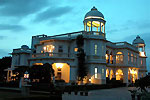 |
|
|
|
|
|
|
|
|
|
|
|
|
|
|
|
|
Gujarat Festivals |
|
|
Gujarat is one of the
diverse and most beautiful state in India. Thousand of small
and big fairs and festivals are celebrated in different
parts of Gujarat every year. The festivals are based on the
lunar or solar calendar. These festivals are observed with
great enthusiasm and fun in which the people of all caste
and religion participate. Today, these festivals are perhaps
the only occasion that represents the true tradition and
culture of Gujarat. Some of the fairs and festivals which
are celebrated in Gujarat throughout the year are
International Kite Festival, Diwali, Holi, Janmashtami,
Kutch Mahotsava, Navratri, Shamlaji Fair, Modhera Dance
Festival, Tarnetar Fair, Bhadra Purnima and Vautha Fair.
|
|
|
|
International
Kite Festival
The International Kite Festival is celebrated on 14th
January, that coincide with the festival of Uttarayan
or Makar Sankranti. The festival is celebrated to mark
the end of winter. On this day, the kites flew all
over Gujarat, including Ahmedabad and Baroda. The
people eat the special food on this day in the open
field or in the park or in the garden of one’s home.
This festival marks the movement of the sun into the
northern hemisphere. The gods who are believed to have
gone in a long sleep for six long months awake and the
portals of heaven are thrown open. The visitors visit
the temples and alms are distributed freely. The kite- |
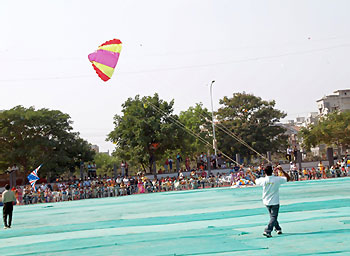 |
|
|
flying starts at dawn and
continues without a pause throughout the day. Friends,
neighbours and total strangers battle one another for
supremacy and cries of triumph fill the air when they cut
each other kites. The thread which is used to fly the kites
are specially prepared by experts before the final day.
Special mixtures of glue and ground glass cover the thread
which is dried and then rolled onto reels known as firkees.
In the night, various illuminated box kites, known as
tukkals, fly in the sky. Today, the International Kite
Festival is famous all over the world. This festival enables
the people of Ahmedabad to see the unusual kites brought by
the visitors, some of which are truly works of art. |
|
|
|
Modhera
Dance Festival
The Modhera Dance Festival is held during the third
week of January every year, after the festival of
Uttarayan. This festival is celebrated at the Sun
Temple in Modhera. The style in which the temple was
built bears a strong resemblance to that of the Jain
temples at Mount Abu. The decision to celebrate the
annual festival of Indian classical dances was taken
by the Department of Culture, Gujarat, and the West
Zone Cultural Centre at the Sun Temple. The idea was
to present classical dances in an atmosphere similar
to that in which these were originally presented. |
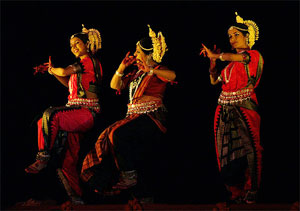 |
|
|
|
|
Kutch Mahotsava
The Kutch Mahotsava is usually organized during February and
March each year. This mahotsava is organized by the Tourism
Corporation of Gujarat Limited in order to promote tourism
in Kutch. In this festival, the visitors are taken on a six
day tour of Kutch. This tour is known as a mahotsava, or
great festival, because of the great variety of sights and
scenes that are offered to visitors. Kutch has everything to
offer to its visitors like the colourful people, historic
towns and remarkable handicrafts.
Bhavnath Mahadev Fair
The Bhavnath Mahadev Fair is held for five days during
Mahashivratri in the month of February. This fair is held at
the Bhavnath Mahadev Temple, located at the foot of Girnar
hill in Junagadh. The events which are associated with the
fair are very colourful. The Mahapuja of Lord Shiva is held
in this temple at midnight, on the 14th day of the dark half
of the month of Magh. When the puja starts, naga bavas
(naked sages) living nearby move towards the fair on
elephants, holding flags and blow conch shells, that sound
tungis and turis. It is also believed that Lord Shiva
himself visits the shrine on this occasion. During this
fair, the visitors are served free meals by the organizers.
In the fair there are special stalls that sell idols, sarees
brought by vendors from Ayodhya and Mathura, utensils of
brass and copper, sweets and fruits. |
|
|
|
Holi
The spring festival of Holi is celebrated on the full
moon day in the month of Phalguna. While Diwali marks
the end of the monsoon and therefore the agricultural
season of the Kharif crop, Holi marks the agricultural
season of the Rabi crop. The next day after Holi is
celebrated as Dhuleti (Dhuli Padvo) when people throw
colour powder at each other and make merry.
Raksha Bandhan
On the festival of Balev or Raksha Bandhan, the
Brahmins change their sacred threads. On the same day
sisters tie Rakhi on their brother's wrist wishing
them a happy life. The day is also celebrated as
Nariyeli Poonam in the coastal areas of the State,
where people worship the sea offering coconuts.
Saptak Music
Festival
Saptak Music Festival of Indian classical music is
usually conducted on the first week of January in
Ahmedabad every year. This festival was inaugurated by
Pandit Ravi Shankar in 1980. The |
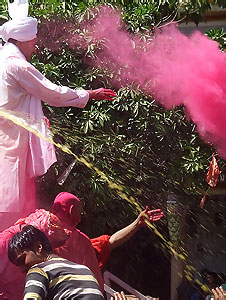 |
|
|
musical event is organised by a public
charitable trust which runs the Saptak School of Music. This
festival which spans the first 11 days of January, showcases
the best talent of more than hundred musicians. |
|
|
|
Janmashtami
Janmashtami, the birthday of Shri Krishna, is
celebrated with great splendour in Dwaraka. The main
deity of Dwaraka is Shri Krishna. During the festival,
the pilgrims visit the temple in Dwaraka from all
parts of India and abroad. In this festival, the rows
of lights are lit everywhere, kirtans and bhajans are
sung, sermons are delivered and Krishna is worshipped
in his infant form. After visiting the main temple,
devotees visit the Shankhoddhar Beyt.
Bhadra Purnima
Fair |
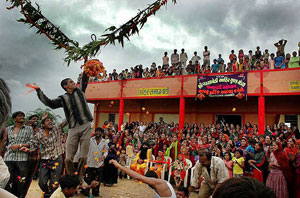 |
|
|
The Bhadra Purnima Fair is
held for three days in the month of September, every year.
This fair is held on the full moon of Bhadrapad at the
temple of the goddess Ambaji in Ambaji. Ambaji is the
principal shrine of the goddess Ambaji in Gujarat. The deity
is represented by a triangular Vishwa yantra, inscribed with
figures and the syllable ‘Shree’ in the centre and there is
no idol. This fact testifies the temple’s antiquity that the
tourists visit the temple during the fair as an essential
part of their lives. On this day, the various agriculturists
and general public visit the temple. In the evening the
Bhavai and garba dances are performed. The devotee attend
readings of the Sapatashati, the seven hundred verses in
praise of the goddess, and visit the temple for an
auspicious view of the deity.
Shamlaji Fair
The Shamlaji Fair, also known as the Kartik Purnima Fair is
held during the month of November, every year. This fair is
held in Shamlaji, about 80 kms from Ahmedabad. The Shamlaji
Temple is a renowned Vaishnav shrine, and the deity housed
therein is known by various names as Gadadhar, bearer of the
mace and Shaksi Gopal. The Shamlaji Fair is celebrated for
about two weeks. About 200,000 people of all communities and
castes including the Garasia and Bhil tribes visit the fair.
The visitors come here from the adjoining districts and from
Rajasthan. Besides visiting the deity in the temple, they
also take a bath in the river Meshwo. The visitors usually
come in groups, and sing devotional songs, carrying
religious banners.
Tarnetar Fair
The Tarnetar Fair, also known as the Trinetreshwar Mahadev
Fair is held at Tarnetar, near the industrial town of
Thangadh, Saurashtra. This fair is one of the most important
fair of Gujarat. The local as well as the tribal people
gather from all over Gujarat to participate in the various
activities that take place at the fair. It is believed that
the fair is held on this ancient site since antiquity. The
fair is also one of the most important matchmaking melas as
the tribal youths visit Tarnetar to find a suitable match.
Its association with the Mahabharat is underlined by the
fact that the area was known as Panchal Pradesh, the land to
which Draupadi belonged. The fair is linked with the story
of Draupadi’s Swayamvar and it is said that it was at this
place that the great archer Arjuna performed the difficult
task that won him his bride. Over 300 stalls are set up in
the fair, that sell numerous objects and offer various types
of food and refreshments. There are exhibitions of
embroidery, a cattle show, competitive sports, family
planning stall, merry-go-rounds and photographer’s stall.
The folk music and dances like the Garba ras and hodo are
the main features of the fair. |
|
|
|
Navratri
Navratri, that means ‘nine nights’ is an ancient,
colourful and religious festival of Gujarat. This
festival is celebrated to honour the one Divine Shakti
or Force which supports the entire universe and is
personified as the Mother Goddess. The Mother Goddess
protects her worshippers, destroys evil and grants
boons to her children. Navratri is celebrated with joy
and enthusiasm throughout the Gujarat, but in
Ahmedabad and Baroda, Garba and Dandia |
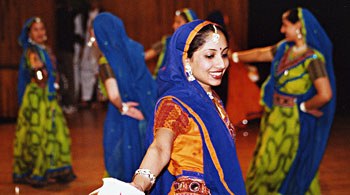 |
|
|
dances are performed. This
festival is celebrated with true devotion in the various
temples which are dedicated to the Mother Goddess. In this
festival, the women perform the Garba dance or the circular
dance around an earthenware pot called a garbo which is
filled with water. A betel nut and a silver coin are placed
within the pot, on the top of which a coconut is placed. As
the dancers whirl around the pot, a singer and a drummer
also accompanies them. The participants clap in a steady
rhythm. The dance usually starts slowly and gets fast with
the music. In large public areas, group of musicians sing
the traditional garba songs. The Dandia ras or ‘stick’ dance
is also performed during Navratri. Both the men and women
perform the dance in circle, holding small polished sticks
or dandies. As per the rhythm of the dance, men and women
strike the dandies together, adding to the joyous
atmosphere. These dances are so popular that sometimes
competitions are held and prizes are given to the best
dancer. The dancers worn the traditional costumes, alive
with colour. The dances usually commence late in the night
and continue until early morning. A Bhavai dance is also
performed in the Ambaji temple at Baroda, during Navratri.
Vautha Fair
Vautha Fair is a magnificent fair that is held every year at
Vautha, where two rivers, Sabarmati and Vatrak meet. This
fair is considered to be one of the largest fairs in
Gujarat. According to the legends the Kartik Swami or
Kartikeya, the son of Lord Shiva, visited the site. This
fair is held during Kartika Purnima, the full moon night of
the month of Kartik, corresponding to the month of November
for 2 to 3 days. The pilgrims who visit Vautha during the
fair come from several communities and include farmers,
laborers and people belonging to several castes. This fair
is visited by Hindus and Muslims in very large numbers. This
fair is also one of the major animal trading fair in
Gujarat. In this fair, about 4000 donkeys are brought every
year for sale, usually by Banjara traders.
Madhavrai Fair
Madhavrai Fair at Madhavpur near Porbandar is held to
celebrate the marriage of Lord Krishna and Rukmini, on the
9th day of the bright half of the month of Chaitra
(March/April).
Urs
The Urs at Shah Alam Roza in Ahmedabad and at Miran Datar in
the Mehsana district are most important fairs for Muslims. |
|
|
|
Diwali
Diwali, the festival of lights is a four-day festival
celebrated in the month of Asvina, which marks the end
of the harvesting season. The first day of the
festival starts with the Lakshmi Puja. The second day
is considered as the day of casting off evils. The
third day is the main Diwali day. On this day every
home is illuminated with earthen lamps and the
courtyards are decorated with Rangoli designs. The
fourth and the last day is the New year day for the
Gujarati's when people visit temples in colourful
costumes and greet each other. The day following the
new year day is called the Bhai bij day when brothers
are invited by their sisters to partake of
|
 |
|
|
sweets with them. The full
moon day of the Kartika month, with its preceding eleventh (ekadashi)
day is called the Dev-Diwali. On these days the marriage of
the Tulsi plant with the Shaligram, symbolising Lord Vishnu,
is celebrated in every Hindu home in Gujarat. It also marks
the end of the fast, observed for the four months of rainy
season, during which Hindus, mostly ladies, miss a meal on
every Ekadashi day.
|
|